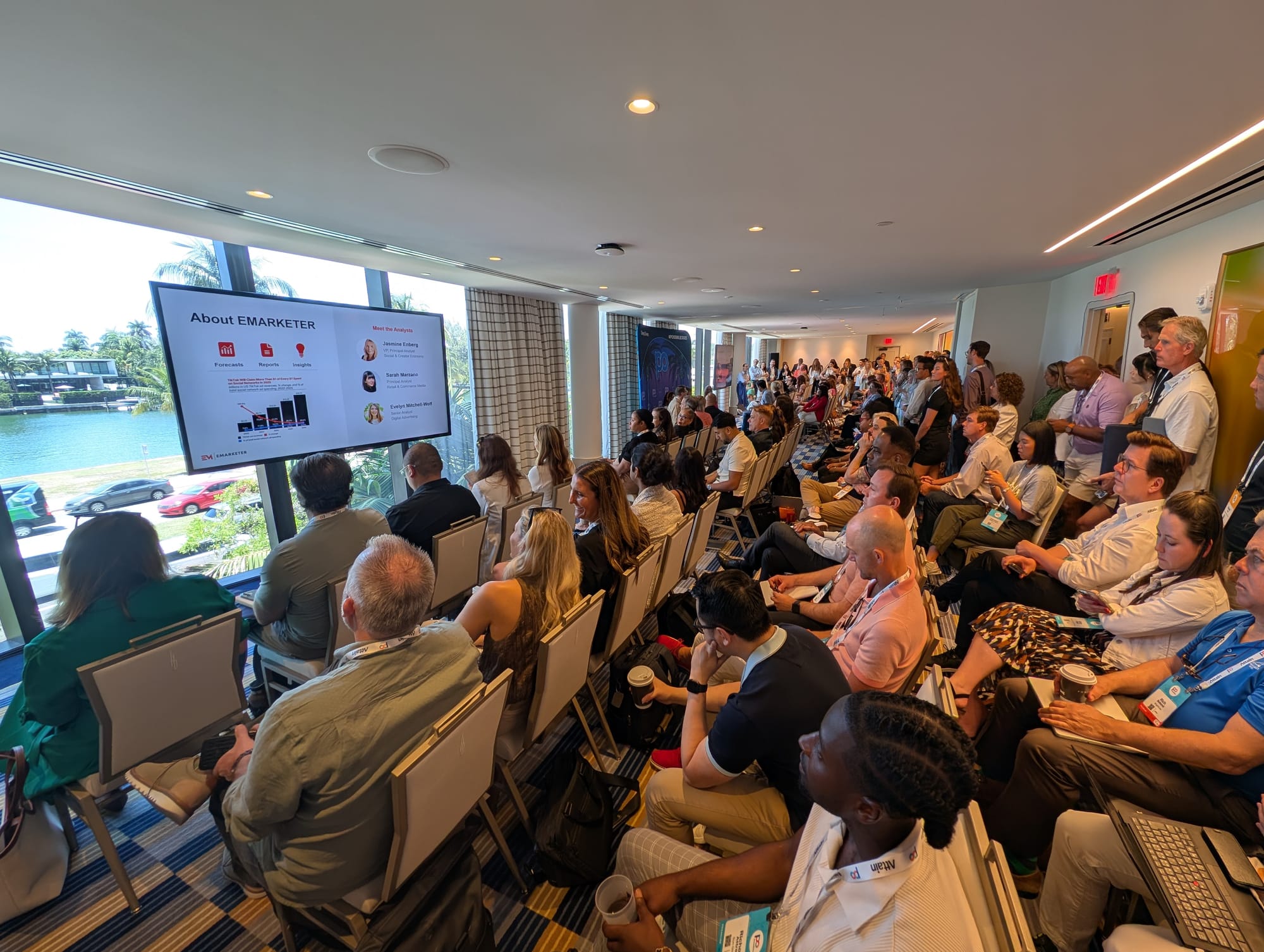Down the hall, up just two tiny elevators, across a sky bridge, down more hallways, then down a flight of stairs, across the street from the Fontainbleu...yesterday's content at POSSIBLE Miami Beach, 2025.
Despite some technical hiccups and background noise (next slide please, am I right?), eMarketer's session covered a number of demonstrable trends.

Myth #1: "Search is Dead"
Since the explosion of Gen AI platforms, industry chatter about the death of search has intensified. While it's true that ChatGPT surpassed Bing in US traffic last September, some perspective is needed: Google still receives over 30 times the traffic that ChatGPT does.
The reality? Search isn't dead. It's evolving rapidly away from Google:
- The search ad market is about five times larger in 2025 than it was in 2015
- Google's grip is loosening as consumer search behavior diversifies
- The average consumer now regularly uses five different search platforms
- Three of the top ten search platforms are retailers (Amazon, Walmart, Target)
- Social platforms continue gaining traction as search destinations
Evelyn Mitchell-Wolf, eMarketer's Senior Analyst for Advertising and Media, emphasized that Google's position has weakened, but search as a category is thriving.
"The days of Google being the only search touchpoint that we were working with are certainly gone," she noted.
What's fascinating is that retail media networks are aggressively monetizing their search functions. Amazon and Walmart now show paid products on virtually every search, while longer-tail retailers are rapidly closing the gap. According to eMarketer, an additional $20 billion will flow into retail media search alone over the next four years.
Myth #2: "Only the Biggest Players Will Succeed"
It's easy to assume that only the triopoly of Google, Meta, and Amazon can win in today's market. But eMarketer's forecast suggests almost $30 billion in new digital ad dollars will flow into the market outside the triopoly between now and 2027. That's some headroom for smaller players.
Concurrent antitrust scrutiny is creating both uncertainty for giants and opportunities for nimbler players:
- Google and Meta face potential breakups
- Amazon has its FTC court date in October
- M&A activity is accelerating across ad tech, martech, and digital content
Jasmine Enberg, VP & Principal Analyst, highlighted a compelling counterexample: creators. US creators will generate over $10 billion from sponsored content on social media alone this year. That is more than YouTube's expected net ad revenues.
Within retail media, the landscape is shifting too. While Amazon captures about 40% of global retail media spending and over three-quarters in the US, its growth rate is decelerating. Meanwhile, Walmart's growth rate for 2025 is projected at nearly double Amazon's.
Sarah Marzano, Principal Analyst, made a comparison between Amazon and Albertsons that puts scale in perspective:
- Amazon's web traffic is 500 times larger than Albertsons'
- But Amazon's Prime membership (180M) is only 4 times larger than Albertsons' loyalty program (44M)
- Albertsons operates 4 times more physical stores than Amazon (including Whole Foods)
"Retail media will not and cannot look the same tomorrow as it does right now," Marzano concluded.
Myth #3: "It's Impossible for Marketers to Control Brand Safety"
Brand safety concerns are legitimate. Social media was identified as the number one channel where marketers expect to face brand safety challenges this year.
Several factors are elevating risk:
- Social media's growing importance to advertising strategies (US social video ad spending will surpass linear TV this year)
- Changes to content moderation programs across platforms
- The rise of user-led content moderation approaches
But the analysts caution against panic. As Jasmine Enberg put it, "Marketers never really had as much control over brand safety as they thought."
She suggests that as platforms take a more hands-off approach, advertisers should become more hands-on with their brand safety strategies.
Even in retail media, traditionally considered a brand safety haven, challenges are emerging.
By 2027, one in every four dollars spent on retail media will be allocated to off-site advertising, meaning retailers will be using their first-party data to target customers across the open web.
So what?
What struck me most about this session wasn't just the myths themselves, but the underlying theme: we've entered what Braun calls "a phase of maturity" in digital advertising. (I will believe it when I see it.)
Growth continues but at a slower pace, creating a zero-sum game where one player's gain is another's loss.
Flexibility and adaptation are critical. The industry leaders of tomorrow may not be the giants of today, and channels that seem secure can quickly become risky.





